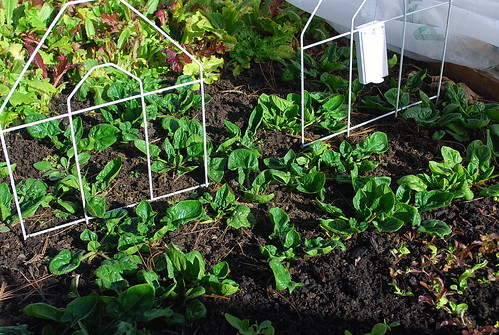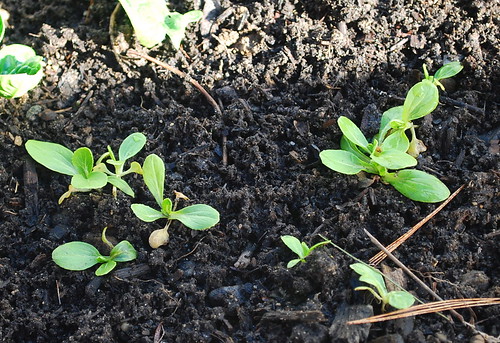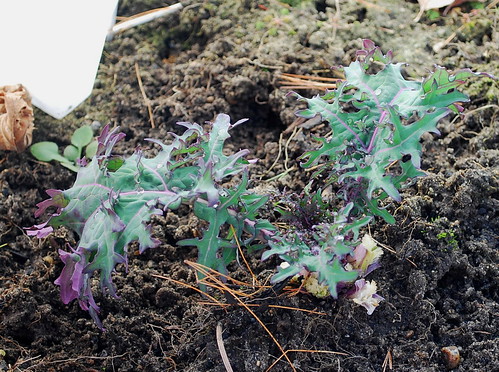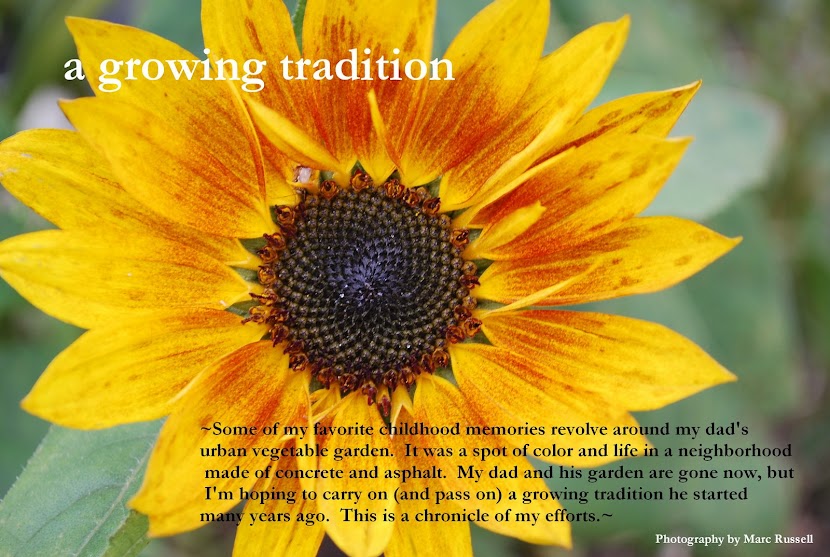
First off, this is the patch of spinach that I have growing under a quick hoop. All that is separating it from the harsh elements is a single layer of 6 millimeter plastic. I took this picture when the outside temperature was in the high 20's F and as you can see, it looks pretty comfortable underneath.

I have another patch of spinach growing inside one of my mini hoop houses. This one is also protected by an inner layer of fabric row cover. The difference between the two is pretty drastic. Although both seem unfazed by the winter conditions, this patch has been much more productive. In fact, while the other patch has stayed seemingly in a state of suspended animation (I did my first cutting this past weekend), this patch is actually growing through the winter months. In the span of 30 days, I've been able to get 2 cuttings from this one. As a result, ALL of my winter veggies next year will be grown under a double layer of protection.

I sowed these pak choi seedlings in late November. As you can see, they've done absolutely nothing during the past couple of months. But what's interesting is that they look perfectly healthy desperate the cold. Next winter, I will experiment more with Asian greens. I have a feeling that if I can get these to size up before December, I can have Asian greens to harvest in December and January.

The Red Russian kale is growing back slowing but surely. I've been able to get a couple of cuttings from last September's sowing. This variety is definitely a keeper. For some reason, I didn't think that Red Russian would be as hardy as other types of kale, like Winterbor. I think the added protection has a lot to do with it. Next winter, I'd like to start this kale indoors in August, plant them out closer together in September, and harvest the leaves at a younger stage all winter long.






Winter gardening has been very productive for you. Spinach looks wonderful. Next year I will have to try to grow it also. There are not much greens that will actually grow during winter. Most of them will, like your pak choi, just wait for spring.
ReplyDeleteIt is interesting that the double layer really adds so much. I wouldn't think it would since it also cuts out the light. It looks like things are going pretty well for you.
ReplyDeleteGlad to see that your winter garden is doing so well. Your work has been an inspiration to me. I built 3 hoop houses over raised beds last fall to overwinter some veges. The winter has been brutal on them, though. The first big snow fall was 3 feet of heavy wet snow. The hoops houses didn't stand a chance, they collapsed under the weight. Two of them bounced back after the snow was cleared. Unfortunately, we've had 3 more heavy, deep snow falls since then. Each one took the hoops houses down. This spring I plan to build a high tunnel hoop house. I think this will be able to withstand the deep snows better. I'm making a list of the varieties that have been successful for you to try next winter. Thanks for sharing your experiences. - Ken
ReplyDeleteI so wish I could do hoop houses again, although I have learned my lesson 2 years in a row here on the coast. Sustained 30-40 mph winds for the entire winter ensure that won't happen. Until I can get a real hard sided structure, I will have to be jealous of yours! Everything looks great!
ReplyDeletevrtlarica - I'm figuring out that a large part of winter gardening is picking plants that will just ride out the weather. You're right, only a few plants are hardy enough to grow during winter.
ReplyDeleteDaphne - Daphne, I thought about that too but evidently, light doesn't appear to be too great of an issue. I tried not to go too heavy on the agribon material. Also, with the leaves gone, my garden actually gets more hours of direct sunlight during the winter.
Ken - Thanks for the kind words. I've had to make an adjustment to my hoop house design with the addition of a cross bar. Luckily, it seems to be doing the trick. Even though we haven't had more than a foot of snow at a time, they seem to be holding up to that. I would love to have a high tunnel next winter as well. You could probably accomplish even more with one.
Erin - luckily, winds haven't been too much of an issue for me, unless the houses are vented open. I hope you do yet your hoop houses again one day!
That is interesting about the row covers adding so much more to the equation. We have had some decent snow this year, but nothing very heavy. I need to bite the bullet and just build something this year.
ReplyDeleteWe garden in a climate similar to yours and also grow spinach and various other greens under our row covers. I might have to try the double layer thing, as you did, next winter. Our spinach does not start growing until March when the weather warms a bit.
ReplyDeleteIsn't kale great! The white Russian does just as well for us as the red.
There's no doubt in my mind a double layer would help considerably since air is a great insulator (the void between the two layers). And abrigon is still light enough to let plenty of light through. Definitely something to consider for my climate, if ever I dare venture into winter gardening ! Nice.
ReplyDeleteThomas, I think it is absolutely amazing what you have accomplished with your garden; I never imagined that one could do that in MA - in the winter- and with no heat. You inspire me (and even at my age). lol
ReplyDeleteBy the way, I thanked you over on my blog for the wonderful seeds. Can't wait to see their little hands waving above the soils surface.
You've done a great job, Thomas! I, being in tropical climate, consider myself a waste when compare to you! I admire you and am glad I found your blog.
ReplyDeleteI'll definitely be back.
Thomas..amazing for the east coast..the hoop house..it must be really warm in there..
ReplyDeletebeautiful looking produce, my friend.....
more later,
kary
Your winter crops have really done well, they look great. We have yet to have a good snow cover so my season extended never sealed fully at the bottom edge. This in turn caused a lot of damage when the frigid weather hit. Looks like we may get that covering of snow tomorrow though, just a little late...
ReplyDeleteI agree with your idea to plant the kale closure together. I am going to stick everything close together this fall to counter the fact that things grow so slowly.
great photos, Thomas. You are an inspiration for anyone thinking about gardening year-round.
ReplyDeleteThe overwintered spinach beds both look good - but it does not surprise me that the extra protected bed is doing better. More important than ambient air temperature... is the soil temps. The extra insulation of a double cover probably really increases the heat retention of the soil.
ReplyDeleteKitsap, that's true. While the soil under the quickhoop is pretty much frozen, the soil under my hoops is just frosty and remains loose most of the time.
ReplyDeleteHopefully the laggers will size up quickly for you come Spring, and you will be enjoying fresh greens while the rest of us are working the soil!
ReplyDeleteThat Red Russian sure does look good, I ordered White Russian seeds this year as well. LOVE the Russian Kales!
Thomas, your winter garden is amazing. Can't believe all that you do with it. Gorgeous spinach. I've never tried the Russian kales. I'm sold on Scotch Dwarf Blue Curled Vates. I planted seeds in fall of 2007, and the plants are still going strong. They're like little trees now, but the younger leaves are still good.
ReplyDeleteThe spinach look lovely!! Yum.
ReplyDeleteIn my opinion the modern winter garden is usually a garden planted either to produce food, or at least to remain visibly planted and slowly develop, throughout the winter, or else a garden whose plants will serve as living decoration all winter.
ReplyDelete